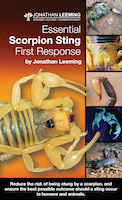
Probably the greatest challenge to the study and research of spider bites is the misdiagnosis, and how this muddles the facts.
Let’s open the can of worms and delve into spiderbite misdiagnosis.
when asked why something thinks they have been bitted by a spider there is normally one of the following answers:
It is very difficult to determine the cause of many spiderbite-like lesions. Considering that 2 medically significant spiders are nocturnal, it is no wonder that the patient does not always see the spider bite them.
Dr Bertrand Russel tried to explain why mankind has such wild ideas such as the world is flat, and Elvis is alive and well. He postulated that there us a small teapot orbiting around the sun, between Earth and Mars. This teapot is too small to be seen through any telescope and too small to be picked by any equipment. Because it is too small, no one can prove with 100% certainty that it actually exists, however, no one prove that it doesn’t exist!
It we consider the probability that the tea pot exists, we can see that it is pretty slim. It is unlikely that NASA went into space, had a nice cup of tea and threw the teapot out into space. Unlikely but not impossible.
[bacteria hypothesis]
Of course you can be bitten by a spider and then get a bacterial infection. It is very possible, but unlikely. Another idea is that spiders have bacteria on their fang. When someone is bitten by the spider, it introduced bacterial which develops into a bacterial infection. It is interesting who people who are afraid of spiders, or who have negative values and beliefs towards them. Are more likely to believe they have been bitten by a spider.
It is easy to learn more things. But, it can be very difficult to unlearn something and re-learn something that is more factual.
[best evidence]
The best evidence of a spiderbite is when the patient watches the spider bite them. If the spider was not seen, then the possibility that it is a spiderbite is questionable.
To be fair, most spider bites are treated symptomatically. Addressing the possibility of a bacterial infection through the use of antibiotics.
In order to answer the questions of it the lesion is spider bite related,
The following are just a few conditions that can easily be misdiagnosed as a spiderbite:
The 2 conditions that are commonly misidentified as a spiderbite are MSA infections and Diabetic ulcers.
Medical professionals often face many challenges when diagnosing spider bites. It’s even more difficult to diagnose a spider bite when the lesion begins to heal or a scar develops.
The Plant Protection Research Institute in Pretoria, houses the National Collection of Arachnida which includes a database of over 50,000 spider records dating back to before 1973. These records are sourced from scientific research and surveys, with a large proportion submitted by the general public from densely populated areas. It’s interesting to note that of more than 50,000 records, only 131 pertain to Violin Spiders. This data demonstrates the scarcity of Violin Spiders in the urban environment.
[medical research]
Research has shown that medical professionals who practice in areas where spider bites regularly occur, are better at recognising the symptoms. In areas where spider bites are rare, misdiagnosis is more frequent. For example, Violin Spider bites are often diagnosed where the spiders are not known to occur. It is possible, but very rare, that spiders are brought into an area through human activities.
A spider will deliver a defensive bite usually only once. Therefore multiple bites occurring over an extended period of time or area, are more likely to be caused by biting insects such as fleas, bed bugs and mosquitoes.
If any of the following is true, the source of the lesion is
more likely to be from a biting insect:
Spider bites are often reported from places where people live in close proximity to each other, for example, prisons, hospitals, hostels, nursing homes and boarding schools. Further investigations at these facilities often result in no spiders being found. In almost every case, the cause will be a bacterial infection (See page 240) and not spiders.
Bacterial infections can be reduced by greater attention to personal hygiene, such as more frequent washing
of hands, showering, more changes of bed linen and clothing. The images that accompany the Violin Spider Hoax Email (See page 173) are a good example of a lesion caused as a result of a bacterial infection.
Tick bites are often misdiagnosed as spider bites. Multiple “spider bites” around the ankles and lower legs, especially after walking through long grass, can often be attributed to ticks.
